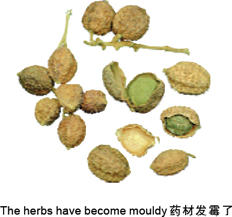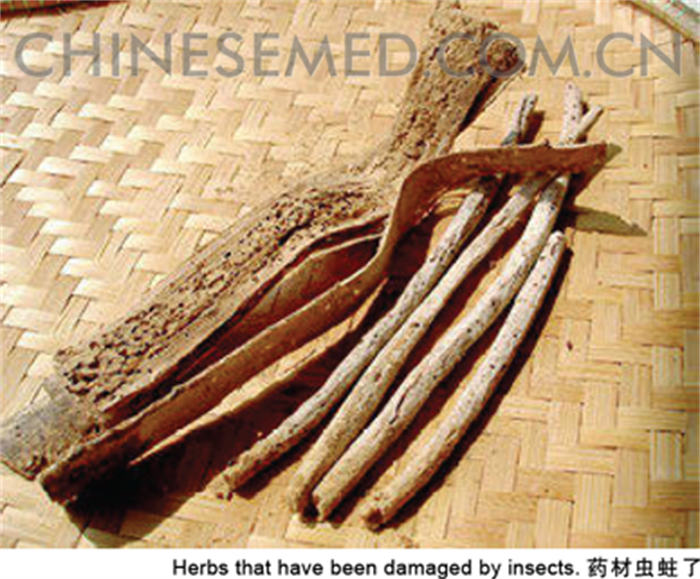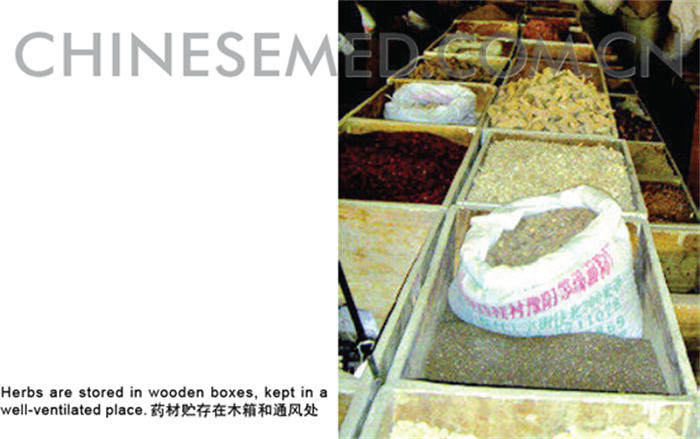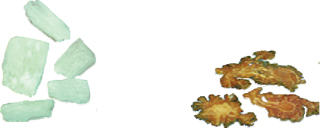If Chinese herbs and patent medicines with no expiry date indicated have been stored at home for a long time, we can use the following guidelines to identify which ones are still usable and which ones have already deteriorated.
Identifying deteriorated medicinal materials:
1. The herbs have been damaged by insects.
If tiny round openings are found on the herb surface, this indicates that the herbs have been damaged by insects. In serious cases, the herbs will decay and disintegrate into a powdery form. This is especially so for herbs containing starch, fats, protein and sugar which aids the breeding of insects.
What should be done?
Prevent insects from breeding by storing herbs in a dry place, in air-tight conditions, at low or high temperatures, or apply the method of antagonistic storage. Dry the herbs and the prepared herbal medicines promptly, prevent contamination and store herbs in a clean, well-ventilated, dry and cool place.
2. The herbs have become mouldy.
If white, yellow or green coloured feathery or threadlike substances, or spots have appeared on the herb surface, it indicates that mould has developed on the herbs. Hot and humid places usually promote the growth of mould very easily.
What should be done?
Prevent the growth of mould by storing the herbs in a wood/fibre box, or an air-tight metal/ceramic container. Add charcoal as a drying agent to absorb moisture.


3. The herbs are oozing oil and have changed colour.
If the herbs become softened and sticky, or if they turn muddy in colour and emit a smell of decaying oil, or if oil-like particles have appeared on the herb surface, then it indicates that the herbs are oozing oil (also known as oil-leaking or zouyou  ). In other cases the natural colour of the herbs may have changed, for instance, some have turned from a light to a dark colour and vice versa, or have changed from white to yellow, or the colour has become less vibrant.
). In other cases the natural colour of the herbs may have changed, for instance, some have turned from a light to a dark colour and vice versa, or have changed from white to yellow, or the colour has become less vibrant.
What should be done?
Prevent the oozing of oil by storing herbs at an even room temperature. Avoid storing them at high temperatures which may cause their oil content to liquefy.
4. The herbs have become odourless.
Every herb has its own unique scent. If the herbs have lost their scent, it shows that the quality of the herbs has been affected, reducing their curative effects.
What should be done?
Prevent loss of scent by storing herbs in an air-tight vat or container.
5. The herbs have turned powdery.
When some herbs are kept in a dry place for a long period of time, the crystalline water originally contained in them will take on a powdery form. This is known as the weathering process. Borax and mirabilite, for example, are easily weathered.
What should be done?
Prevent weathering by storing herbs in an air-tight vat or container, which should be kept in a cool place.
6. The herbs have turned watery.
If the herb’s original solid state has become liquid, they have deliquesced and dissolved.
What should be done?
Prevent deliquescence and dissolution by storing herbs in air-tight containers which should be kept in a dry and well-ventilated place.

7. The herbs have cracked.
If herbs with volatile oil are no longer lubricated but appear dry and have cracks, then it shows that the herbs have volatilised. Eagle wood and cinnamon bark are examples of herbs which are easily volatilised.
What should be done?
Prevent volatilisation by keeping the herbs below a temperature of 60 degrees Celsius while they are dry. Store them in a cool and dry place, but note that these types of herbs are not suitable for long-term storage.
8. The herbs have become rotten.
If the fresh herbs emit heat and have become rotten, they are no longer suitable for use. Fresh ginger, fresh or dried rehmannia root, and fresh reed rhizome become rotten easily.
What should be done?
Prevent decomposition by using the herbs promptly, or store them at low temperature. Such herbs are not suitable for long-term storage.

Identifying deteriorated patent medicines:
1.Oral liquidi  : Suspension of particles or precipitate in the liquid, muddy colour, sour taste, gas gushes out or the bottle explodes upon opening.
: Suspension of particles or precipitate in the liquid, muddy colour, sour taste, gas gushes out or the bottle explodes upon opening.
2.Tablet  : Breaks down into pieces, changes colour or becomes sticky. Some sugar-coated tablets may be externally uneven but still good internally.
: Breaks down into pieces, changes colour or becomes sticky. Some sugar-coated tablets may be externally uneven but still good internally.
3.Capsule  : Softened and sticky, or internally agglomerated, becoming hardened and mouldy.
: Softened and sticky, or internally agglomerated, becoming hardened and mouldy.
4.Granule  : Sticky, mouldy, agglomerated or hardened.
: Sticky, mouldy, agglomerated or hardened.
5.Powder  : Hardens, damp, changes colour or agglomerates.
: Hardens, damp, changes colour or agglomerates.
6.Decocted extract  and syrup
and syrup  : Turns mouldy or changes colour, contains sediment or suspended particles, and the bottle releases a smell upon opening or air bubbles float up.
: Turns mouldy or changes colour, contains sediment or suspended particles, and the bottle releases a smell upon opening or air bubbles float up.
7.Pills  : The pill surface turns mouldy, breeds insects, gets sticky, softens or protrusions appear.
: The pill surface turns mouldy, breeds insects, gets sticky, softens or protrusions appear.
8.Soft herb plaster  : Oil or water oozes out, the colour changes, or it becomes sparse or hardens.
: Oil or water oozes out, the colour changes, or it becomes sparse or hardens.

